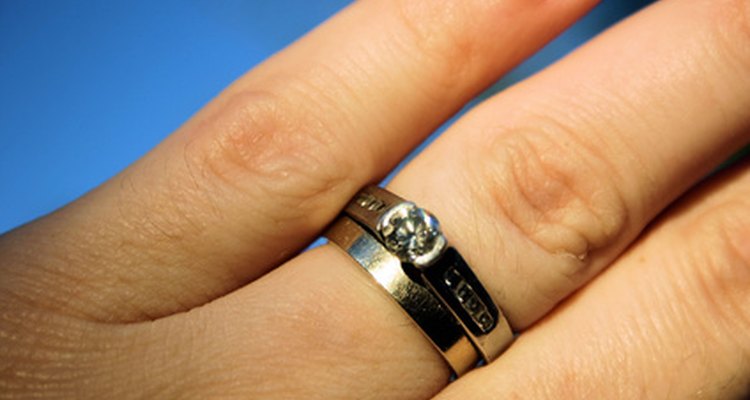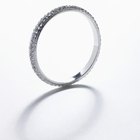
Just because your finger turns green after wearing a certain ring, it doesn't mean that it comes from cheap material. Several reasons exist for skin discoloration when wearing jewelry, and the problem can be easily fixed by cleaning jewelry frequently or removing jewelry when using certain products or chemicals. Before replacing the jewelry that's causing your skin to turn black or green, think about all of the known causes and preventions.
Abrasion
Skin changes colors where jewelry is worn due to metallic abrasion. Cosmetics that contain zinc oxide, titanium dioxide, ferric oxide and calamine can rub off tiny particles of the metal on jewelry, therefore leaving them on your skin and coloring it black. These chemical compounds that are found in cosmetics are much harder than the jewelry itself, which is why it can wear off the metal on earrings, necklaces and rings. Avoid cosmetics that contain these chemicals, or remove metal jewelry if you wear these kinds of cosmetics.
Perspiration and Corrosion
Gold often mixes with silver or copper to harden for use in jewelry. If these alloys get wet, then corrosion may occur, leaving your skin discolored. Frequently, perspiration from jewelry wear causes corrosion, especially if enough salt buildup from sweat is present. Sterling silver is most susceptible to corrosion due to perspiration. To such discoloration, remove jewelry often or permanently when perspiring.
Tarnishing
Sterling silver is prone to tarnish due to contact with sulphur compounds. When the silver tarnishes, the jewelry turns black, which can then rub off on skin and cause black discoloration. Those people with moist skin may also notice green discoloration due to tarnished sterling silver. To avoid discoloration caused by tarnishing, polish your jewelry regularly with a silver cleaner or a silver polishing cloth.
Photographic Chemicals
Photographic or photo processing chemicals often contain nitric acid. When silver comes into contact with nitric acid, it causes an intensely black stain. If you work with these photographic chemicals or solutions, then wear gloves or remove rings before use to avoid discoloration on the skin.
Antibiotics
Certain antibiotics and medications are also known to cause discoloration in the skin. Sometimes, the body chemistry reacts specifically to gold or silver, causing metal to tarnish, and thus, a black or green trace on the skin. Those who are prone to skin discoloration should opt for a higher karat since they contain fewer elements of metals and more gold, which lowers the chance of irritation.
Buildup
Skin redness or an allergic reaction results from metal jewelry coming into contact with soap, detergent, wax, polish or cosmetic cream buildup under the jewelry. To prevent a rash or redness of the skin, clean jewelry frequently and remove jewelry when using cleaning materials such as soap and detergent.
Related Articles

What Causes Earrings to Change Color?

How to Clean Sterling & Turquoise ...

What Is Black Titanium?

Can You Serve Food From Sterling Silver?

How to Clean Vermeil

How to Clean Silver Jewelry With Vinegar

Sealing Oxidation on Jewelry

How to Polish a Dull Amber Ring

Why Does a Platinum Ring Dent?

How to Keep Gold Plated Jewelry From ...

How to Remove Gold Plating

How to Use Colloidal Silver to Kill ...

How to Clean Silver Jewelry With ...

Silver Polish Ingredients

Does Stainless Steel Jewelry Turn Green?

How to Clean Palladium Jewelry

How to Get Rust Out of Silver

How to Store Silver Jewelry So It Won't ...

Harmful Effects of Wearing Magnetic ...

Types of Coral Jewelry
References
Writer Bio
Shauna Heathman is a certified image consultant with a passion for writing, and has been writing since 2006. She has maintained a blog of her own for three years in which she writes on topics concerning self development, appearance, style, etiquette and communications. Heathman has a bachelor's degree in communication studies and an entrepreneurship certificate from the University of Iowa.
Photo Credits
a ring image by Allyson Ricketts from Fotolia.com